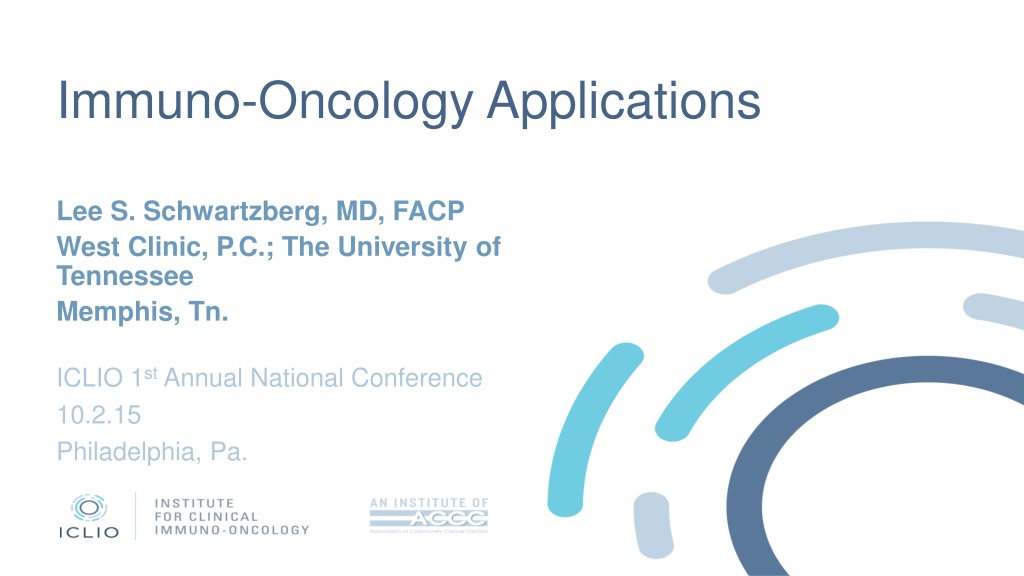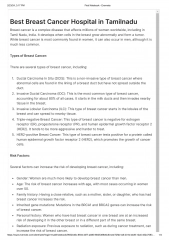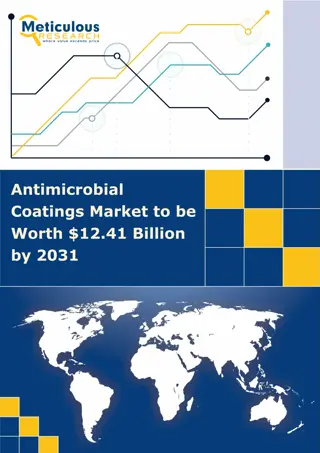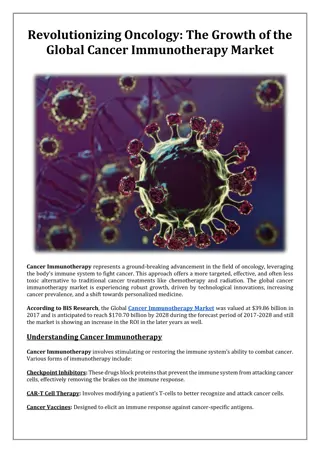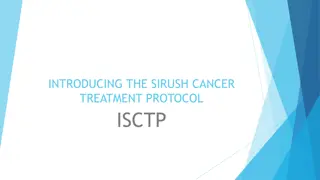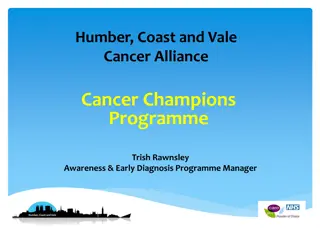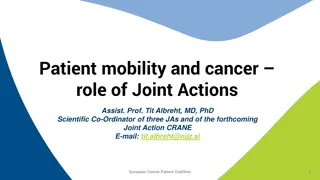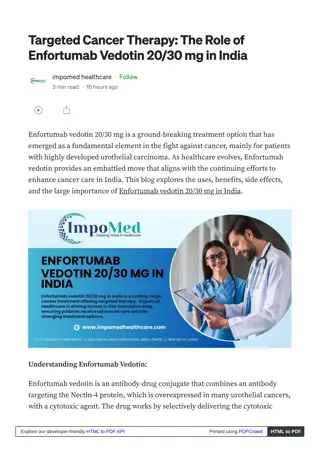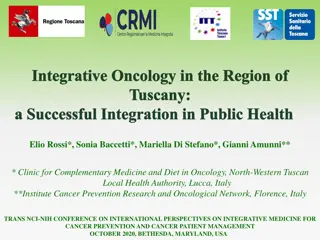Evolution of Immunotherapy in Cancer Treatment
The history and advancements in cancer immunotherapy are highlighted, from early observations in the 1890s to the development of modern immunotherapies in the 2000s. Concepts such as immunosurveillance theory and the role of T cells in recognizing tumor-associated antigens are discussed, leading to the emergence of effective immunotherapy strategies like vaccines and checkpoint inhibitors to combat cancer. The evolution of cancer treatments through immunotherapy represents a significant breakthrough in oncology.
Download Presentation

Please find below an Image/Link to download the presentation.
The content on the website is provided AS IS for your information and personal use only. It may not be sold, licensed, or shared on other websites without obtaining consent from the author. Download presentation by click this link. If you encounter any issues during the download, it is possible that the publisher has removed the file from their server.
E N D
Presentation Transcript
Immuno-Oncology Applications Lee S. Schwartzberg, MD, FACP West Clinic, P.C.; The University of Tennessee Memphis, Tn. ICLIO 1st Annual National Conference 10.2.15 Philadelphia, Pa.
Financial Disclosures I do not currently have any relevant financial relationships to disclose
Off-Label Use Disclosures I do not intend to discuss off-label uses of products during this activity.
Concept of immunotherapy to treat cancer has been around for over a century 1890s William Coley observed a cancer patient with complete remission following infection from the bacteria Streptococcus pyogenes Dr. Coley injected streptococcal cultures Coley s Toxin - into patients and observed some cases with tumor regression Most patients had inoperable sarcomas; cure rate was over 10% Studies like Dr. Coley s led to the use of bacilli Calmette-Guerin (BCG) which is used today to treat bladder cancer (source: Parish, 2003)
Immunosurveillance theory supports the view of an immune response against tumors 1960s Sir Frank Burnet publishes his immunosurveillance theory: lymphocytes eliminate malignant cells via recognition of tumor-associated antigens (TAA) (proposed earlier by Paul Erlich; refines views held by Lewis Thomas) Sir Frank Burnet (taken from Parish, 2003) Mid-1970s Spontaneously arising tumors not recognized by the immune system Mid to Late 1980s T cells can be recruited to respond to transformed cells; identifications of many TAAs; cytokine approved by FDA to treat cancer (sources: Parish, 2003; Lee and Margolin, 2011)
The New Era of Cancer Treatments: Immunotherapy 1990s to the 2000s Major advances in molecular biology, cell-signaling pathways, identifications of antigens, and targeted therapies/monoclonal antibodies as cancer therapies Immuno-deficient mice and tumor incidence Modified thinking about how tumors evade immune detection 2010 to Present: Immunotherapies result in impressive tumor responses: o Immunotherapy vaccine o Checkpoint inhibitors o Other immunotherapies in development; combination regimens
Immunotherapy has become a standard of care in cancer Examples of Immuno-oncologic agents: Cytokines (mid-1980s) elicit an immune response against the tumor; examples of include interferons (e.g. interferon alfa-2b (1986) and interleukins (aldesleukin (1992)) Vaccines (mid-1980s, 2010) introduce the immune system to tumor-associated antigens; immune system recognizes and attacks tumor cells associated with the antigen (e.g. Bacillus Calmette-Guerin (mid-1980s) sipuleucel-T (2010)) Checkpoint Inhibitors (2011) Tumors escape detection from the immune system by expressing checkpoint proteins on their cell surface; targeting and inhibiting these cell surface proteins enhances the immune response to the tumor (e.g. ipilimumab (2011), nivolumab (2014), pembrolizumab (2014)) Others: Cell therapies (e.g. CAR T cells), Monoclonal antibodies (e.g. alemtuzumab)
Checkpoint Inhibitors: Mechanisms of Action Checkpoint inhibitors: CTLA-4 Inhibition PD-1 Inhibition ACTIVATION INHIBITION ACTIVATION INHIBITION T Cell T Cell T Cell PD-1 PD-L1 CTLA-4 CTLA-4 B7 Tumor Cell CD28 CD28 B7 Ipilimumab (anti-CTLA- 4) Tumor Cell APC APC APC = Antigen-Presenting Cell Immuno-oncology agents such as checkpoint inhibitors are changing the treatment paradigm for many oncology disease states = Nivolumab or pembrolizumab (anti-PD-1)
The CTLA-4 inhibitor ipilimumab dramatically improved survival for patients with advanced melanoma Patients with unresectable or metastatic melanoma previously treated with one or more of the following: aldesleukin, dacarbazine, temozolomide, fotemustine, or carboplatin: HLA-A2*0201 genotype** Overall Survival (OS), median ipilimumab + gp100* (n=403) ipilimumab (n=137) gp100 (n=136) 10 months 10 months 6 months * gp100 is an investigational peptide vaccine ** facilitates immune presentation of the investigational peptide vaccine (source: Yervoy (ipilimumab) FDA approved label, Bristol-Myers Squibb
Pembrolizumab and nivolumab demonstrated impressive response rates for patients with metastatic melanoma experiencing disease progression Pembrolizumab: Unresectable or metastatic melanoma with progression of disease, refractory to: two or more doses of ipilimumab, disease progression within 24 weeks following the last dose of ipilimumab, if BRAF V600 mutation-positive, refractory to a BRAF or MEK inhibitor. Results: 89 patients taking the 2mg/kg dose of pembrolizumab pembrolizumab (2 mg/kg) Overall Response Rate (ORR) 24% (one complete response, 20 partial responses) Nivolumab: Progression of disease on or following ipilimumab treatment and if BRAF V600 mutation positive, a BRAF inhibitor Results interim analysis: 120 patients taking 3 mg/kg dose of nivolumab nivolumab (3 mg/kg) Overall Response Rate (ORR) 32% (four complete response, 34 partial responses) (sources: Keytruda (pembrolizumab) FDA approved label, Merck; Opdivo (nivolumab) FDA approved label, Bristol-Myers Squibb)
Nivolumab was approved earlier this year as subsequent therapy in patients with metastatic NSCLC Approval for squamous NSCLC was based on two studies: Phase III (n=272), nivolumab (3 mg/kg) vs. docetaxel (75 mg/m2); metastatic squamous NSCLC, disease progression during or after one prior platinum doublet based chemotherapy Median Overall Survival (OS) = 9.2 months on nivolumab (n=132) vs. 6.0 months on docetaxel (n=137) Phase II, single-arm, nivolumab (n=117); progression after a platinum-based therapy and at least one additional systemic treatment ORR = 15%, all partial responses, median time to onset of response = 3.3 months 76% (13 of 17 patients) with a confirmed response had ongoing responses, 10 of the 17 had durable responses of 6 months or longer Nivolumab is also recommended for subsequent therapy use in patients with metastatic non-squamous NSCLC: Phase III, previously treated advanced non- squamous NSCLC Nivolumab 3 mg/kg (n=292) Docetaxel 75 mg/m2 (n=290) Median Overall Survival 12.2 months 9.4 months Objective Response Rate 19% 12% Median Duration of Response 17.2 months 5.6 months (sources: Opdivo (nivolumab) FDA approved label, Bristol-Myers Squibb; Rizvi, et al., 2015; : Paz-Ares et al., 2015)
Immuno-oncology agents are being developed as both monotherapy and in combination with other agents to treat a number of tumor types Bladder Breast Colorectal Esophageal Gastric Head and Neck Hepatocellular Leukemia Lung Lymphoma Melanoma Ovarian Pancreatic Prostate Renal Cell Carcinoma 12
Considerations for healthcare providers when using immunotherapy to treat patients with cancer: Response patterns to immunotherapy may differ compared to the responses observed with cytotoxic agents Novel therapies with novel mechanisms of action can result in specific treatment-related adverse events (i.e. immune-related Adverse Events (irAEs))
The unique MOA of immuno-oncology agents requires modified tumor response criteria Conventional RECIST guidelines may not provide a complete assessment of immunotherapy tumor response: Anti-tumor response to immunotherapy may take longer compared to cytotoxic agent response Clinical response to immune therapies can manifest after conventional progressive disease (PD) pseudoprogression Discontinuation of immune therapy may not be appropriate in some cases, unless PD is confirmed Allowance for clinically insignificant PD (e.g., small new lesions in the presence of other responsive lesions) is recommended Durable stable disease may represent antitumor activity 14 (source: Wolchock et al., 2009)
Patterns of response observed in patients with advanced melanoma treated with ipilimumab TUMOR RESPONSES THAT GO AGAINST STANDARD CRITERIA CONVENTIONAL TUMOR RESPONSES Responses after an initial increase in total tumor burden Response in baseline lesions stable disease with slow, steady decline in total tumor volume Reduction in total tumor burden during or after the appearance of new lesions 15 SPD = sum of the product of perpendicular diameters; Triangles = ipilimumab dosing time points; N=tumor burden of new lesions (source: Wolchock et al., 2009)
Differences between WHO (World Health Organization) classification and irRC WHO irRC Always represent PD Incorporated into total tumor burden New Measurable lesions (> 5 x 5 mm) Always represent PD Do not define progression (but preclude irCR) New non-measurable lesions (<5 x 5 mm) Changes contribute to defining best overall response Contribute to defining irCR Non-index lesions 16
Application of immune-related Response Criteria Complete disappearance of all lesions and no new lesions; confirmation by a repeat consecutive assessment no less than 4 weeks from the date first documented irCR decrease in tumor burden >50% relative to baseline confirmed by repeat consecutive assessment at least 4 weeks later irPR irSD not meeting criteria for irCR or irPR in absence of irPD increase in tumor burden >25% relative to nadir (minimum recorded tumor burden) confirmed by repeat consecutive assessment at least 4 weeks later irPD 17
Healthcare providers will need to recognize and manage irAEs related to immunotherapy Adverse Events differ in patients taking cytotoxic agents versus patients taking immunotherapy checkpoint inhibitors irAEs associated with checkpoint inhibitors*: Dermatologic Toxicities Enterocolitis / Gastrointestinal related Endocrinopathies Hepatotoxicities Pneumonitis *discussed in more detail during the 11:30am session
Immuno-Oncology: Challenges & Considerations Rapid approval of immunotherapies for on- and off-label indications o Payers may struggle to keep up with the amount of supporting clinical data constantly being published; this could affect coverage Increasing use of immunotherapies in combination (e.g. chemo, targeted biologics, other immuno-oncologic agents) may drive cost upwards resulting in tighter payer-management of these agents (Pre- cert, step therapy, use of biomarkers (e.g. PD-L1 expression) Requirement of resources o Involvement of the entire multidisciplinary team (physicians, pharmacists, nurses) and patients: Communication/coordination, education, updating protocols o Reimbursement staff 19
Summary Concept of immunotherapy has been around for over a century; today, immunotherapy is changing the treatment paradigm for many oncology disease states with impressive tumor responses in hard-to-treat cancers Immuno-oncology agents are being developed to treat a number of tumor types (monotherapy and in combination with other agents or other immunotherapies) Healthcare providers will need to consider response patterns and immune- related adverse events when using checkpoint inhibitors to treat patients with cancer A number of challenges have the potential to affect immunotherapy utilization: reimbursement related issues, administrative hassles, utilization of resources, etc.
References Keytruda (pembrolizumab) FDA approved label, Merck Lee, S. and Margolin, K. Cytokines in Cancer Immunotherapy. Cancers 2011; 3:3856-3893. Opdivo (nivolumab) FDA approved label, Bristol-Myers Squibb Parish C.R. Cancer immunotherapy: The past, the present and the future. Immunology and Cell Biology 2003; 81:106-113. Paz-Ares, L. et al. Phase III, randomized trial (CheckMate 057) of nivolumab (NIVO) versus docetaxel (DOC) in advanced non-squamous cell (non-SQ) non-small cell lung cancer (NSCLC). J Clin Oncol 33: 2015 (suppl; abstr LBA 109) Rizvi, N.A. et al. Activity and safety of nivolumab, an anti-PD-1 immune checkpoint inhibitor, for patients with advanced, refractory squamous non-small-cell lung cancer (CheckMate 063): a phase 2, single-arm trial. The Lancet Oncology 2015; 16(3):257-265. Wolchock et al. Guidelines for the Evaluation of Immune Therapy Activity in Solid Tumors: Immune Therapy Activity in Solid Tumors: Immune-Related Response Criteria. Clinical Cancer Research 2009; 15:7412-7420 Yervoy (ipilimumab) FDA approved label, Bristol-Myers Squibb
Panel Discussion
